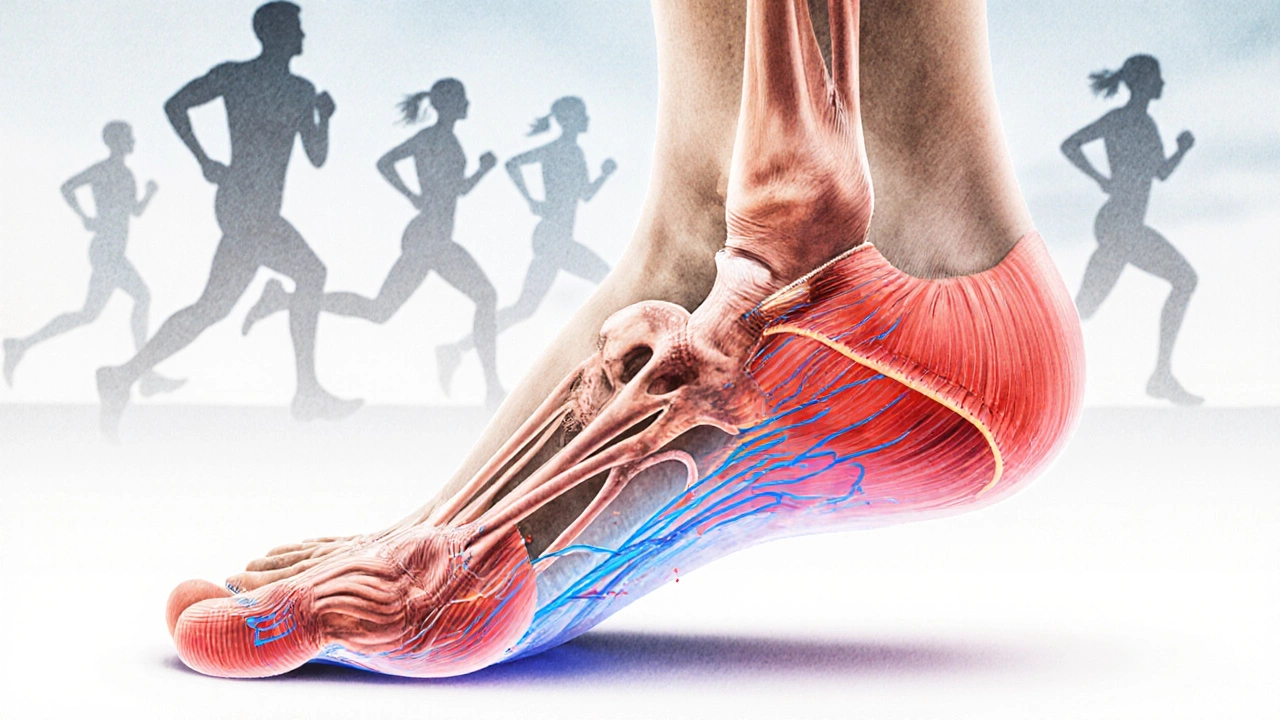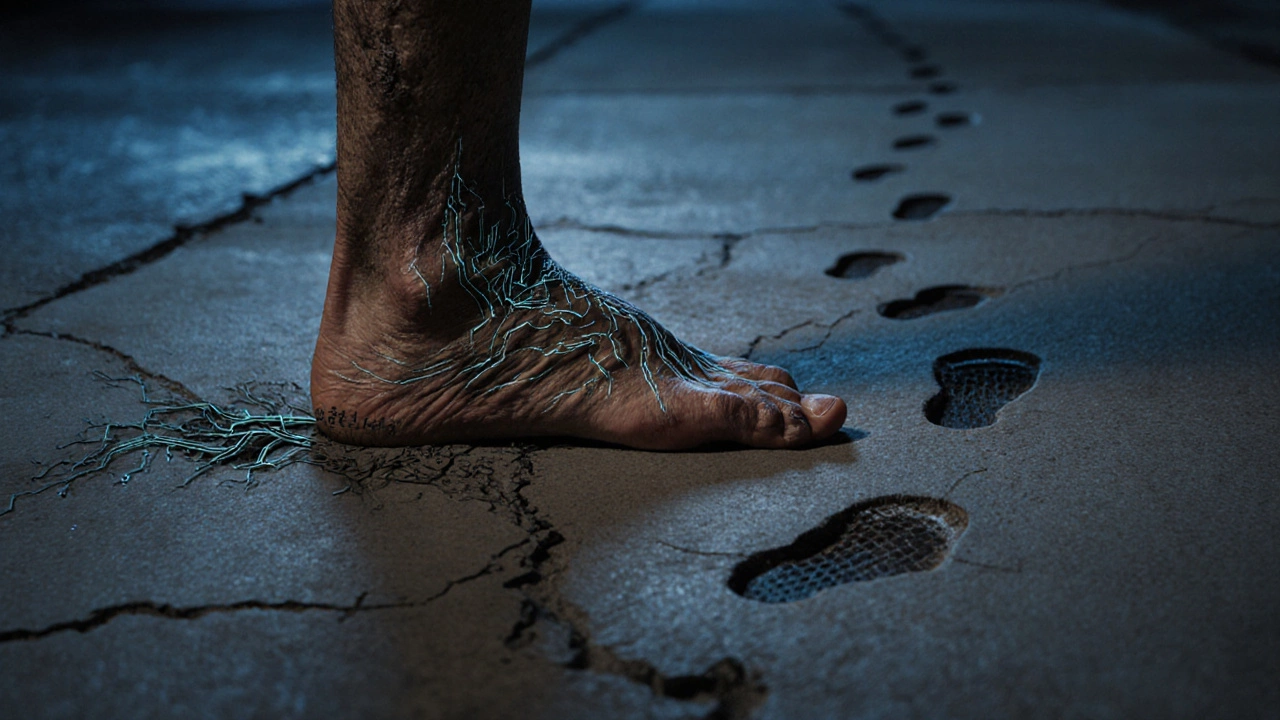Is barefoot running good? The real pros, cons, and science behind going shoeless
 Nov, 5 2025
Nov, 5 2025
Barefoot Running Transition Calculator
How to use this tool
Enter your current running details to get a personalized transition plan. Remember: never jump into barefoot running—your body needs 6-12 months to adapt properly.
You’ve seen them-runners gliding down the sidewalk with no shoes, toes splayed, feet slapping the pavement like they’re dancing. Some call it natural. Others call it reckless. So, is barefoot running good? The answer isn’t a simple yes or no. It depends on your feet, your history, and how you approach it.
What barefoot running actually means
Barefoot running doesn’t mean running around in socks or sandals. It means letting your feet move without cushioning, arch support, or heel elevation. Some people run completely barefoot. Others use minimalist shoes-thin soles, zero drop, wide toe boxes-that mimic the feel of bare skin on the ground.
The idea isn’t new. Humans ran for millions of years without modern running shoes. The first running shoe with significant cushioning didn’t appear until the 1970s. Before that, runners landed on their midfoot or forefoot because landing on the heel with no padding hurt. Modern shoes, with thick heels and arch support, changed how we run-and that’s where problems started.
The science behind foot strike and impact
When you run in traditional shoes, your heel hits the ground first. That creates a sharp impact force-sometimes up to three times your body weight-traveling up your leg. Your body absorbs that shock through your knees, hips, and lower back.
When you run barefoot or in minimalist shoes, your foot naturally lands on the ball or midfoot. That shifts the impact from your joints to your tendons and muscles, especially the Achilles and plantar fascia. Studies from the Journal of Experimental Biology in 2010 showed barefoot runners generate less collision force than shod runners, even when running at the same speed.
But here’s the catch: that doesn’t mean barefoot running is automatically better. Your body has to be ready for it. If your calves and feet are weak from years of cushioned shoes, suddenly switching can lead to injury.
Who benefits from barefoot running
Not everyone should try this. But some people see real improvements:
- Those with chronic knee pain-reducing heel strike can ease pressure on the joint
- People with plantar fasciitis who’ve tried everything else-strengthening the foot arch naturally often helps more than orthotics
- Runners who feel stiff or heavy on their feet-barefoot running encourages lighter, quicker steps
- Those who want to reconnect with movement-many report feeling more grounded, more aware of their stride
One runner from Perth, 42, switched after five years of plantar fasciitis. He started with 5 minutes of barefoot walking on grass, then added 100-meter barefoot sprints twice a week. After six months, his pain vanished. He now runs 80% of his mileage in minimalist shoes.
The risks: what can go wrong
Jumping straight into barefoot running is like trying to lift heavy weights without warming up. Common injuries include:
- Achilles tendonitis-your calf and Achilles aren’t used to the extra load
- Metatarsal stress fractures-sudden increase in forefoot impact
- Blistering and cuts-especially on rough surfaces
- Plantar fascia strain-too much too soon overwhelms the arch
A 2014 study in the British Journal of Sports Medicine found that runners who switched to minimalist shoes too quickly had a higher injury rate than those who stayed in traditional shoes. The key isn’t the shoe-it’s the transition speed.

How to try barefoot running safely
If you’re curious, start slow. Here’s a realistic plan:
- Begin with barefoot walking on soft surfaces-grass, sand, or a rubber track-for 5-10 minutes a day, 3-4 times a week
- After two weeks, try 1-2 minutes of barefoot jogging on grass, then walk the rest
- Week 3-4: Increase jogging to 3-5 minutes, still only on soft ground
- Week 5+: Try 10% of your normal run in minimalist shoes on pavement. Keep the rest in your usual shoes
- Listen to your body. If your calves ache or your arches burn, stop and walk for a few days
Don’t rush. It takes 6-12 months to fully adapt. Your feet need to build strength, your tendons need to thicken, and your nervous system needs to relearn how to land.
Minimalist shoes vs. barefoot
You don’t have to go completely barefoot. Minimalist shoes offer protection without interfering with natural movement. Look for these features:
- Zero drop (heel and forefoot at same height)
- Thin sole (4-8mm thick)
- No arch support
- Wide toe box (toes can spread naturally)
- No cushioning or motion control
Popular models include the Merrell Vapor Glove, Vibram FiveFingers, and Altra Lone Peak. These aren’t designed to cushion your stride-they’re designed to let your foot do the work.
What to avoid
Don’t:
- Switch overnight-your body needs months to adapt
- Run on concrete or gravel early on-start on grass or dirt
- Ignore pain-sharp pain isn’t normal, even if it’s "just your feet getting stronger"
- Think it’s a magic fix-barefoot running won’t cure poor form or overtraining
Also, avoid shoes labeled "minimalist" that still have cushioning, arch support, or a tapered toe box. Many brands market shoes as minimalist just to sell more. True minimalist shoes feel like wearing nothing at all.

Who should skip barefoot running
Some people shouldn’t try this at all:
- Those with diabetes or neuropathy-loss of sensation increases injury risk
- People with severe flat feet or structural deformities-unless cleared by a physio
- Runners with recent stress fractures or tendon injuries
- Anyone who can’t commit to a slow, patient transition
If you’re unsure, get a gait analysis from a sports physio. They can tell you if your foot structure supports barefoot running-or if you need more support.
Real results, real time
One runner in Sydney, 58, started barefoot running after hip replacement surgery. He was told to avoid impact. He didn’t. He began with 3 minutes of barefoot walking on the beach every morning. After 18 months, he ran his first 10K in minimalist shoes. He says his hips feel better than they have in 20 years.
Another runner, 29, switched after three knee surgeries. He reduced his impact by changing his foot strike. He didn’t eliminate pain overnight-but over time, his knees stopped hurting. He still runs in minimalist shoes, but only 40% of his weekly miles.
Final verdict: is it good?
Barefoot running isn’t a miracle cure. It’s not for everyone. But for those willing to be patient, it can retrain your body to move more efficiently, reduce joint stress, and strengthen your feet in ways shoes never could.
The best outcome? You don’t need to run barefoot forever. You just need to give your feet the chance to feel the ground-so they remember how to work.
Can barefoot running help with plantar fasciitis?
Yes, for some people. Plantar fasciitis often comes from weak foot muscles and over-reliance on shoe support. Barefoot running strengthens the arch naturally by forcing the foot to engage with every step. But only if you transition slowly. Jumping into it too fast can make it worse. Start with walking barefoot on sand or grass, then slowly add short runs. Many report relief after 3-6 months of consistent, gentle practice.
Do I need special shoes for barefoot running?
Not necessarily, but minimalist shoes are recommended for most people. They protect your feet from glass, rocks, and hot pavement while still letting your foot move naturally. True minimalist shoes have zero drop, no arch support, a thin sole (under 8mm), and a wide toe box. Avoid anything labeled "minimalist" that still has cushioning or a narrow toe area-those are marketing tricks.
How long does it take to adapt to barefoot running?
It takes 6 to 12 months to fully adapt. Your tendons, muscles, and bones need time to strengthen. Most people make the mistake of running too far too soon. Start with 5-10 minutes a week of barefoot walking, then slowly add short jogging intervals. Don’t increase distance by more than 10% per week. Patience is the key.
Is barefoot running better than running with shoes?
It’s not better-it’s different. Barefoot running reduces impact forces on your knees and hips by changing how your foot lands. But it puts more demand on your calves, Achilles, and foot muscles. If your body isn’t ready, you’ll get injured. Traditional shoes protect you from impact but can weaken your feet over time. The best approach? Mix both. Use minimalist shoes for some runs, and traditional shoes for long distances or rough terrain.
Can I run barefoot on pavement?
You can, but not at first. Pavement is hard and unforgiving. Start on grass, sand, or a rubber track. After several months of building foot strength and refining your form, you can slowly introduce short stretches of pavement. Even then, limit it to 10-20% of your total mileage. Always check the surface for debris-glass, nails, or hot asphalt can cause serious injury.